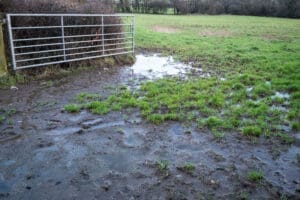Southern Oregon and Northern California boast a diverse landscape that can turn any backyard into a lush oasis. However, with our wet winters and dry summers, water management is crucial to prevent yards from turning into water-logged swamps. Preventing water-logged soil is one of the most challenging aspects of landscaping for many local property owners. To help you create an outdoor living space you can enjoy, we’ve created a short guide to landscaping with tips to keep your yard thriving without drowning in excess water.
 9 Tips for Preventing Water-logged Soil:
9 Tips for Preventing Water-logged Soil:
1. Understand Your Soil
The first step in preventing water-logged soil is understanding the composition of your soil. Many Southern Oregon and Northern California areas have heavy clay soils that can become easily waterlogged. Add organic matter like compost or well-rotted manure to improve drainage, enhance the soil structure, and promote better water infiltration.
2. Choose Native and Drought-Resistant Plants
Interestingly, the plant life in your landscaping can help with preventing water-logged soil. Selecting the right plants is pivotal to a successful landscaping venture. Opt for native species adapted to the region’s unique climate. Native plants are well-suited to the local soil and weather conditions, requiring less water and maintenance. Additionally, integrate drought-resistant plants that can withstand the dry spells of summer without compromising on aesthetics.
3. Implement Efficient Irrigation Systems
An efficient irrigation system is the backbone of a water-wise landscape. Drip irrigation, soaker hoses, and smart irrigation controllers can help ensure water is delivered directly to the root zones, minimizing evaporation and runoff. Consider installing a rain sensor to automatically adjust your irrigation schedule based on weather conditions, saving water during the rainy season. These techniques will eliminate overwatering and make your other strategies for preventing water-logged soil easier to manage effectively.
4. Create Graded Slopes
Our region’s topography can be challenging, especially in areas prone to waterlogging. To combat this issue, create graded slopes to direct water away from buildings and low-lying areas. Utilize natural contours and add swales or channels to redirect water runoff, preventing it from pooling in unwanted areas and creating a swampy mess.
5. Install Permeable Surfaces
Reduce water runoff and promote infiltration by incorporating permeable surfaces into your landscape design. Gravel paths, permeable pavers, and even strategically placed rocks can help prevent waterlogging by allowing rainwater to percolate into the soil rather than running off the surface.
6. Mulch for Moisture Regulation
Mulching is a simple yet effective way to regulate soil moisture. Apply a layer of organic mulch, such as bark chips or straw, around your plants to retain soil moisture, suppress weeds, and protect the soil from erosion. Mulch also helps insulate plant roots from extreme temperatures, ensuring they thrive in our varied climate.
7. Strategic Plant Placement
Consider the natural water flow on your property when placing plants. Plant water-loving species in low-lying areas where water tends to accumulate while placing drought-resistant plants in higher, well-drained spots. This strategic placement prevents waterlogging and creates visually appealing and functional zones within your landscape.
8. Regular Maintenance
Regular maintenance is vital for preventing water-logged soil issues from creeping up. Clear debris from gutters and downspouts to ensure proper water drainage from roofs. Trim overgrown plants to maintain adequate air circulation and prevent excess shade, which can contribute to damp conditions.
9. Rain Gardens
Consider incorporating rain gardens into your landscaping design. These are shallow, planted depressions designed to capture and absorb rainwater runoff. By selecting plants that thrive in wet and dry conditions, rain gardens help prevent waterlogging and add a touch of natural beauty to your yard.
Choose Hilton Landscape Supply for Everything You Need for a Beautiful Yard and Garden
Landscaping can be a rewarding experience, transforming your outdoor space into a thriving oasis. By understanding the local climate and soil conditions and implementing water-wise practices, you can create a sustainable and visually stunning landscape that thrives without succumbing to the pitfalls of waterlogging. Embrace these tips, and watch your yard flourish year-round in this unique and enchanting corner of the Pacific Northwest. Visit us at Hilton Landscape Supply for more tips and tricks to creating the outdoor living space of your dreams.

 9 Tips for Preventing Water-logged Soil:
9 Tips for Preventing Water-logged Soil: